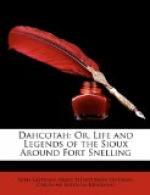However they may have been improved, no one could have had better opportunities than I, to acquire all information of interest respecting these Indians. I lived among them seven years. The chiefs from far and near were constantly visiting the Fort, and were always at our house. Not a sentiment is in the Legends that I did not hear from the lips of the Indian man or woman. They looked on my husband as their friend, and talked to him freely on all subjects, whether of religion, customs, or grievances. They were frequently told that I was writing about them, that every body might know what great warriors they were.
The men were sometimes astonished at the boldness with which I reproved them, though it raised me much in their estimation. I remember taking Bad Hail, one of their chiefs, to task, frequently; and on one occasion he told me, by way of showing his gratitude for the interest I took in his character, that he had three wives, all of whom he would give up if I would “leave Eastman, and come and live with him.” I received his proposition, however, with Indian indifference, merely replying that I did not fancy having my head split open every few days with a stick of wood. He laughed heartily after his fashion, conscious that the cap fitted, for he was in the habit of expending all his surplus bad temper upon his wives. I have sometimes thought, that if, when a warrior, be he chief or commoner, throws a stick of wood at his wife’s head, she were to cast it back at his, he might, perhaps, be taught better behaviour. But I never dared to instil such insubordinate notions into the heads of my Sioux female friends, lest some ultra “brave,” in a desperate rage, might substitute the tomahawk for the log. These opinions, too, might have made me unpopular with Sioux and Turks—and, perchance, with some of my more enlightened friends, who are self-constituted “lords of creation.”
I noticed that Indians, like white people, instead of confessing and forsaking their sins, were apt to excuse themselves by telling how much worse their neighbors were. When told how wicked it was to have more than one wife, they defended themselves by declaring that the Winnebagoes had twice or thrice as many as the Sioux. The attempt to make one right of two wrongs seems to be instinctive.
I wished to learn correctly the Indian songs which they sing in celebrating their dances. I sent for a chief, Little Hill, who is a famous singer, but with little perseverance as a teacher of music. He soon lost all patience with me, refused to continue the lesson, declaring that he could never make me sing like a Sioux squaw. The low, guttural notes created the difficulty. He very quickly became tired of my piano and singing. The chiefs and medicine men always answered my questions readily, respecting their laws and religion; but, to insure good humor, they must first have something to eat. All the scraps of food collected in the kitchen; cold




